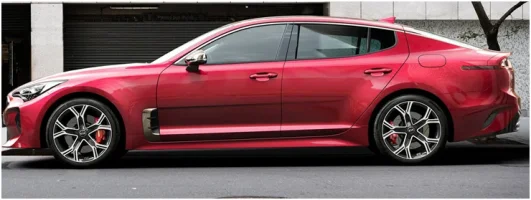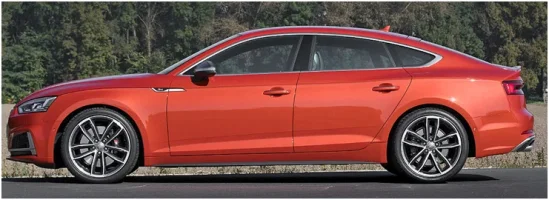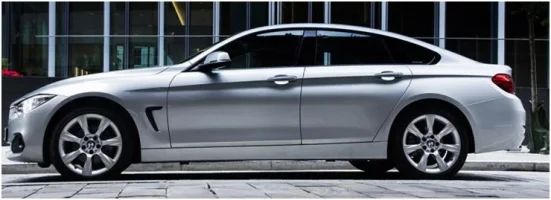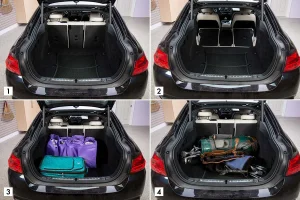Great minds think alike,
@ralzod "beat" me by seconds:
Attached is the PDF file you may want to look at, and this is the commentary:
Why Cargo Specs Can Stretch the Truth
By
Kelsey Mays
March 10, 2014
CARS.COM — When
Acura redesigned its popular MDX crossover for 2014, press materials specified 90.9 cubic feet of maximum cargo room, a significant increase over the prior MDX's 83.5 cubic feet. Still, something didn't quite add up. The new MDX was 2 inches longer from bumper to bumper, but height and width had decreased 1.5 and 1.3 inches, respectively. How had cargo room increased 8.9 percent?
Related: Which Seven-Passenger SUV Has the Most Cargo Room?
Acura explained: Maximum cargo room was actually
68.4 cubic feet, not 90.9 cubic feet. It explained both numbers in the fine print on its consumer website as "based on [the] SAE J1100 cargo volume measurement standard plus floor space between first and second seats and front seats moved forward. This figure compares more accurately with most competitive measurements."
That should certainly clear things up for shoppers trying to find a car with enough room to get the kids to soccer practice or cross-country for a summer vacation.
What Acura doesn't say is that you can't even compare the 68.4 cubic feet in the 2014 model with the 2013 MDX's 83.5 cubic feet because Acura derived the numbers from different versions of SAE J1100. SAE J1100 is a widely adopted methodology from the
Society of Automotive Engineers to measure interior space, but its roots go back more than five decades.
The Tower of Babel
Why is it so hard to compare cargo space? It's because different automakers follow different cargo space accounting methods. The methodology in question, called SAE J1100
Motor Vehicle Dimensions, is rooted in SAE drafting standards from 1963. A formal version was approved in 1973 with comprehensive revision in 1975. Eight subsequent versions came between 1984 and 2009, explained Neil Mitchell, a senior design engineer at GM. But there's little consistency as to which version automakers use. Toyota said it employs the 1975 version, which it says the EPA mandates for cargo volumes that classify a car as subcompact, compact and so on. Hyundai said it uses the 2002 version; Honda said it uses the 2005 version. Chrysler, GM and Ford said they use the 2009 version.
Six of the seven automakers we contacted use four different versions of the standard. The seventh automaker, Nissan, did not respond to our queries.
Honda told us in an email from its Ohio-based engineering group that the revisions change little.
The basic formula is the same: Take a cargo area and measure the length, width and height. Multiply it all together and that's your cargo room, explained Manda Mustaine, a vehicle-packaging specialist in Ford's engineering division.
But the versions of SAE J1100 alter which spaces in a car can be measured in the first place.
The Real World
"The inside of a vehicle is not uniform," Mustaine said. "You have wheel wells. You have a curved roof surface. It depends on where exactly you would measure." Most measures take an average between two lengths, two widths and two heights, she said. That accounts for the uneven nature of interior space, at least somewhat, because multiple measurements allow somewhat for, say, the curved tailgate or bulky wheel wells. But "there is potential that someone could take advantage of a potential nuance in the surface of the vehicle and say, 'Oh, no, no, we're allowed to measure this point here,' " Mustaine said.
Those dimensions can be manipulated by seat positioning, storage nooks and more. The Acura example illustrates this: The old MDX was measured using the 2002 version of J1100, said a former Honda representative who asked not to be named. (Acura is Honda's luxury division.) The redesign was measured using the 2009 version. If you measure the new MDX using the same method as its predecessor, its cargo room goes to roughly 75 cubic feet from 83.5 cubic feet, the spokesman said; measure it with the 2009 revision and the number falls to 68.4 cubic feet.
We compared photos of the previous generation and current generation with golf clubs behind the third row. You can see that even with the difference in measurements, there is little practical change to cargo space.
The redesigned 2013 Toyota RAV4 has a maximum cargo room of 73.4 cubic feet and 38.4 cubic feet with the rear seats in place, significant numbers in the class. When Jeep revealed specs of its all-new Cherokee SUV (which is longer and wider than the RAV4), the numbers did not look good in comparison at 54.9 cubic feet max and 24.8 cubic feet with the seats in place. Look at the side-by-side photo (below) with our grocery bag test (10 recyclable bags filled with identical items) and the extra 13.6 cubic feet behind the second row looks like it can accommodate only one or two extra bags in the Toyota. That's not a huge real-world advantage.
What about seating position? Updates to J1100 through much of the 2000s attempted to clarify just where the seats go before you measure cargo space. Some used a robotic seat-measuring tool. Others reverted to SAE-spec mannequins with 95th percentile legs and 50th percentile torsos, Ford's Mustaine said.
The result created some consistency as to where the seats go before an automaker measures cargo room, but variances are possible.
"Can you influence things a little bit here and there? Yes," Mustaine said. "Just think of the seatback angle. So even if you use different [driving] positions, whatever you define as your seatback angle ... that can have more of a significant impact" on cargo room.
Trunk Versus Open Space
The
type of cargo area matters, too. SAE stipulates a different method to measure space in an enclosed trunk in a sedan or coupe. Automakers have to fit SAE-specified blocks that simulate luggage parcels into the trunk and add them up. But the open spaces in SUVs, minivans, wagons and hatchbacks don't lend themselves easily to these blocks, and that's why the SAE and regulators invented the length/width/height calculations, GM's Mitchell explained.
That means you can't compare a sedan's trunk with a hatchback's cargo area and declare one larger than the other using only SAE cargo specs.
Take the Ford Focus as an example. It comes in sedan and hatchback form. The hatchback's cargo area behind the second row is rated at 23.8 cubic feet while the sedan's trunk is rated at 13.2 cubic feet. Looking at the images it's hard to see where the 10.6 added cubic feet would come into play in the grocery store parking lot. Stacking items above the top of the rear seat could be dangerous to passengers.
"In general, the enclosed-trunk method yields a result about 10 to 15 percent lower than the precise volume of the trunk because its purpose is to represent the usable cargo space for actual things owners will want to pack," Honda's engineers told us.
The Bottom Line
At the end of the day, automakers don't have to follow SAE guidelines when they publish cargo volumes. "If you look at the code of federal regulations, they state which procedure you're supposed to use when you look at [interior] volume," GM's Mitchell said. "But then you can measure it any way you want and use it in your advertising."
"SAE is not a governing body," Ford's Mustaine noted. "There is no advertising standard that is required by law."
All six automakers that responded to our questions said they follow SAE guidelines. Numbers can lie, so bring some salt and make sure you stack up our real-world cargo photos alongside those numbers when doing your research.
Editor's note: This post was updated on March 10 to reflect that SAE J1100 is rooted in 1963 drafting standards.
Attached File:
sae.j1100.2001.pdf
See Page 42-51, 11.2 cntd.
And this is a German commentary from 2013:
Size specifications for trunks can deceive
The full package?
STEFAN WEISSENBORN
30.07.2013 13:41
Numbers can simulate objectivity - this also applies to the trunk space of cars. The liter specifications of the manufacturers do not say how the trunk is shaped, what luggage will fit or how well it can be loaded. There is also criticism about the measurement method.
420 liters or 500 liters? Information on the storage space volume is often the key when purchasing a car. Customers ask themselves, for example: will all my favorite suitcases fit into my favorite car? Or: Is the alternate choice of car perhaps good enough because it offers space for all that luggage? With this in mind, car buyers should be skeptical about the manufacturers' volume data - for several reasons.
Luggage compartment volume: From DIN, ISO and VDA (Association of German Car Manufacturers)
The data in the car brochures are comparable to each other. The volume of a trunk space is determined by a standardized method. It is based on DIN and ISO standards and is referred to as the VDA standard in Germany since the DIN standard is based on a recommendation of the Association of the Automotive Industry . "The method has been the benchmark for decades," says VDA spokesman Eckehart Rotter. The storage space of a car according to DIN 70020 (part 1) with measuring blocks measuring 200 x 100 x 50 millimeters (= 1 liter) is measured by filling it up with these foam blocks . The ISO standard 3820, developed according to the DIN model, allows larger cuboids with a volume of up to eight liters, so that measurements can be made more quickly.
ADAC (German Automobil Club) measures with different blocks
The method sounds objective but in the opinion of the ADAC it is only conditionally practicable. For this reason, the automotive club has set itself the task of finding better orientation values with one-liter cuboids in the DIN dimensions during its own vehicle tests. "Small compartments, which are not usable for luggage, we calculate separately," says ADAC engineer Martin Ruhdorfer. These include double bottoms or stowages in the side panels of the trunk.
Their volume is not added to the main storage space. "It is better for the car owner to be specified less, but really usable storage volume."
For example, is it permissible to add the stowage space in the spare wheel well to the standard volume if a car is equipped with a tire repair kit? For such special cases, the standards from the 1990s do not resole this, according to the VDA. " The parameters were not laid down that precisely," says Rotter - which leaves lee-way or fudge factor for the manufacturers..
For example, in the Audi A4 limousine, the ADAC Munich arrives at 380 liters, whereas the AUDI H.O. in Ingolstadt comes in at a DIN volume of an even 100 liters more. Even more striking is the comparison of the BMW 3 Touring Model : 340 liters vs. 495 liters. In contrast, the luggage compartment of the Ford Focus is very useful, of the promised by Ford 363 DIN-liters, 345 liters remain in the ADAC test.
"Interestingly high values"
"The auto brochures often state interesting high values", ADAC engineer Ruhdorfer observed. The standard, for example, prescribes measuring the normal volume up to the height of the rear seat backrests - but these can be inclined on some models. And the steeper they stand, the larger volumes can be measured and printed in the product brochures. For this reason, the ADAC measures as a rule to the lower edge of the window - apart from sedans, where the question of the loading height does not arise.
Often manufacturers provide maximum values, which are determined according to norm, but are only applicable when the vehicle is not fully occupied when traveling - for example, because individual seats or the entire seat are folded or even removed.
Access is crucial
Often the volume up to the inside of the roof is also indicated. If loading the vehicle this way, baggage nets are necessary in order to protect the occupants from loose objects in the event of a crash. In addition, the driver can not observe the rear traffic through the rear view mirror, reminds Ruhdorfer. For security this is not optimal, but legally not a problem. This does not apply to sedans, because their separate luggage compartment can only be extended - if at all - by a ski bag.
Distribution of the volume is important
Ruhdorfer admits that the liter statements can easily deceive, even those of the ADAC. "It is difficult to make a purchase decision on the basis of volume alone." It is important, for example, how the volume distributes itself - how high is a trunk, for example. "With sedans, the volume can be large, because the storage space is often wide and deep - but you can not get a baby carriage or walker in there."
It depends on the shape of the block (cuboid) measurement
A better idea of the usable storage space is given to consumers by means of the cuboid dimension, which is stated in maximum
usable height, width and depth. However, it does not necessarily appear in the brochures of the manufacturers, Ruhdorfer has stated.
The ADAC measures the trunk of cars with foam bricks
Look at the trunk opening
A piece of advice therefore always applies: Before the purchase of the car put the luggage compartment under a magnifying glass. Customers should balance the size of the trunk opening with their needs, recommends Ruhdorfer. Especially sedans and some coupés are often too small for bulky items of luggage.
Bulky items don’t often fit sedans and coupés
How little volume pronouncements by manufacturers actually say about the practical usability, shows the example of the luggage compartment of the VW Golf VII. Volkswagen indicates a minimum usable volume of 380 liters, but the ADAC has determined only 305 liters. The difference of 75 liters is explained by the fact that the ADAC did not include the spare tire depression and the storage space below the variable loading floor - at the lowest setting. On the other hand, Ruhdorfer finds the double bottom in the Golf practical: it can be adjusted at the level of the loading edge, which makes the loading and unloading of heavy objects easier - measured values be damned.
A piece of advice therefore always applies: Before the purchase of the car the trunk space should be put under a magnifying glass. Customers should consider their needs and balance the size of the trunk opening with their requirements, recommends Ruhdorfer. Especially sedans and some coupés are often too small for bulky items of luggage.
And last but not least, a side profile comparison of the usual suspects. It's hard to say which car has the objective advantage - never mind the manufacturers data, but my vote would go for the Porsche, after all it's the longest of the bunch and has a fairly rounded stern.

WB 114.4” L 190.2” H 55.1”

WB 110.7” L 185.5” H 54.8”

WB 110.6” L 182.5” H 54.6”

WB 116.1” L 198.8“” H 56.0”











